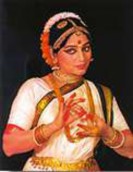Bharatnatyam Dance
Bharatnatyam Dance is considered to be over 2000 years old. Several texts beginning with Bharata Muni's Natya Shastra (200 B.C.E. to 200 C.E.) provide information on this dance form. The Abhinaya Darpana by Nandikesvara is one of the main sources of textual material, for the study of the technique and grammar of body movement in

Bharatnatyam Dance. There is also a great deal of visual evidence of this dance form in paintings and stone and metal sculptures of ancient times. On the gopurams of the Chidambaram temple, one can see a series of Bharatnatyam poses, frozen in stone as it were, by the sculptor. In many other temples, the charis and karanas of the dance are represented in sculpture and one can make a study of the dance form.
Bharatnatyam dance is known to be ekaharya, where one dancer takes on many roles in a single performance. In the early 19th century, the
famous Tanjore Quartette, under the patronage of Raja Serfoji are said to have been responsible for the repertoire of Bharatnatyam dance as we see it today.
The style was kept alive by the devadasis, who were young girls 'gifted' by their parents to the temples and who were married to the gods. The devadasisperformed music and dance as offerings to the deities, in the temple courtyards. Some of the renowned performers and gurus of the early part of the century belong to the devadasi families, a well- known name is Bala Saraswati.

The repertoire of Bharatnatyam is extensive, however, a performance follows a regular pattern. At first there is an invocation song. The first dance item is the alarippu, literally meaning - to adorn with flowers. It is an abstract piece combining pure dance with the recitation of sound syllables.
The next item, the jatiswaram is a short pure dance piece performed to the accompaniment of musical notes of any RAGA of Carnatic music. Jatiswaram has no SAHITYA or words, but is composed of ADAVUS which are pure dance sequences - NRITTA. They form the basis of training in Bharatnatyam dance.
As a solo dance, Bharatnatyam leans heavily on the abhinaya or mime aspect of dance - thenritya, where the dancer expresses the SAHITYA through movement and mime. Shabdam follows the jatiswaram in a
Bharatnatyam dance performance. The accompanying song is generally in adoration of the Supreme Being.
After the shabdam, the dancer performs the varnam. The varnam which is the most important composition of the Bharatnatyam repertoire, encompasses both nritta and nritya and epitomises the essence of this classical dance form. The dancer here performs complicated well graded rhythmic patterns in two speeds showing the control over rhythm, and then goes on to depict in a variety of ways, through abhinaya the lines of the sahitya. This portrays the dancer's excellence in abhinaya and also reflects the endless creativity of the choreographer.
The varnam is by far one of the most beautiful compositions in Indian dance.
After the strenuous varnam, the dancer performs a number of abhinaya items expressing a
variety of moods. The bhava or RASA is woven into the sahitya and then expressed by the dancer. The common pieces are keertanam, kritis, padams and javalis. In the keertanam, the text is important whereas kriti is a composition in which the musical aspect is highlighted. Both are usually devotional in character and represent episodes from the lives of Rama, Siva, Vishnu, etc. Padams and javalis, are on the theme of love, often divine.
A Bharatnatyam performance ends with a tillana which has its origin in the tarana of Hindustani music. It is a vibrant dance performed to the accompaniment of musical syllables with a few lines of sahitya. The finale of the piece is a series of well-designed rhythmic lines reaching a climax. The performance ends with a mangalam invoking the blessings of the Gods.
The accompanying orchestra consists of a vocalist, a mridangam player, violinist or veena player, a flautist and cymbal player. The person who conducts the dance recitation is the Nattuvanar.
